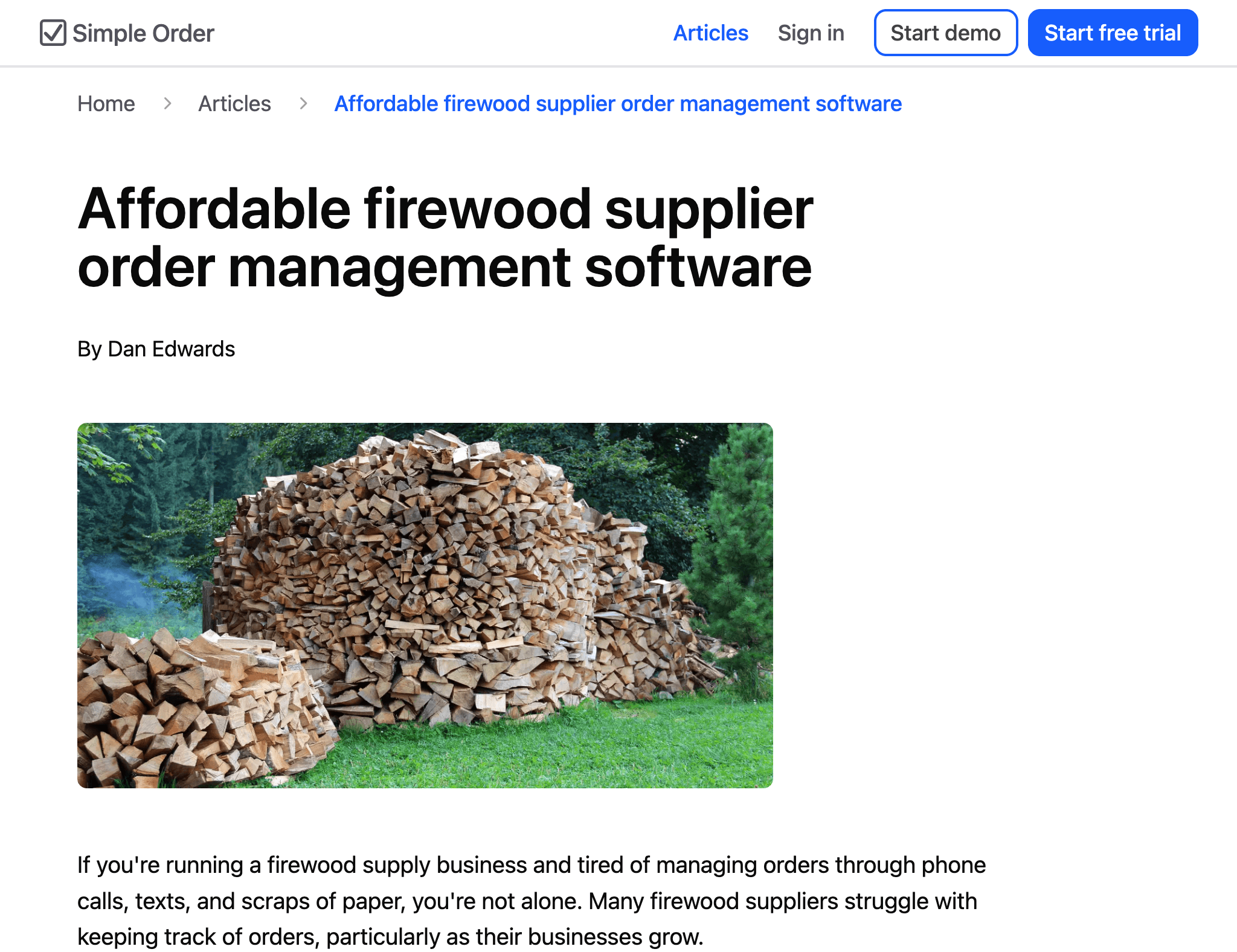Overview
Small wholesale businesses, such as bakeries, florists, and timber merchants, often struggle with order management.
Many rely on phone calls, Excel spreadsheets, scraps of paper, or even their memory because existing software solutions are complicated and cost up to £150 per month.
Since January 14, 2025, I have developed Simple Order to create a blue ocean in this underserved market with an affordable, intuitive order management platform priced at just £20 per month.

Inspiration
Two years ago, my mum bought a village shop, and through her experiences with various B2B companies, I've gained insider insight into the frustrations of existing solutions.
Most suppliers she works with still take orders by phone because the current software offerings are either too expensive or too complex for their needs.
This represents a classic blue ocean opportunity: creating uncontested market space by serving businesses that don't currently use software rather than convincing people to switch over from alternatives.

Key innovation: Comprehensive demo
Instead of requiring users to sign up before seeing the product, I've built a sophisticated demo system that showcases the product's full functionality without interacting with the database.
This solves the friction problem I identified across 20+ competitors, as none of them offer immediate product exploration.
The architecture utilises shared components (such as `InventoryPageContent`) that accept props for data and functions, which are called from both live routes (`/inventory`) and demo routes (`/demo/inventory`).
The live version uses functions that interact with the database, whereas the demo uses client-side data only, with subtle delays to emulate a network request. This provides an authentic user experience while keeping the code incredibly DRY.
Here's a simplified example:
Programmatic content generation
I've implemented programmatic content generation targeting 47 specific industries, using my background in SEO content writing to create high-quality articles that cater to businesses such as artisan food producers, craft breweries, and speciality manufacturers.
These articles are hidden from the `/articles` page but are listed in the `sitemap.xml`.
This strategy is already showing results - according to Search Console data, the site was ranking on the second page of Google results for several key terms just one week after implementation.

Product-led growth strategy
Inspired by books such as Product-Led Growth, The Lean Startup, and Blue Ocean Strategy, I've designed Simple Order around immediate value delivery:
How it works
- **Friction-free trials** - Wholesalers start immediately without credit card details
- **Fast onboarding** - Users can add their inventory and customers in minutes
- **Elegant order management** - Clean interfaces for order placement and fulfilment
- **PDF invoice generation** - Quickly print or save generated invoices, eliminating manual paperwork
- **Multi-currency support** - Localised experiences at `/usd`, `/eur`, and `/cad`, etc., with middleware-based location detection and redirection

Deliberately avoided features
Following blue ocean principles, I've omitted complexity that doesn't add value:
- **No payment processing** - Merchants prefer direct bank transfers to avoid fees
- **No product photos** - Merchants have product marketing brochures already
- **No delivery management** - This isn't a pain point for most small wholesalers
- **No order confirmation emails** - Browser/database confirmation is sufficient and more reliable
Architecture highlights
- **Next.js** - The full-stack framework built on top of React, deployed with Vercel
- **Hybrid rendering** - Static generation for SEO-critical pages, SPA experience for applications
- **React-email** for stylish transactional emails
- **Multi-currency infrastructure** - Automatic routing and localisation using Vercel's edge network headers
- **Sophisticated forms** - Zod validation with React Hook Form for seamless user experiences at critical conversion points
- **End-to-end type safety** - Custom API system ensuring predictability across the stack using TypeScript discriminated unions
Performance
All public-facing pages have perfect or near-perfect Lighthouse scores, thanks to the use of optimised images, dynamic imports, and strategic code splitting.

Database & integrations
- **PostgreSQL with Drizzle ORM** deployed with Neon
- **Stripe API** for subscriptions
- **MailGun with React-email** for transactional emails

Continuous learning
Throughout the process, my continuous learning in code, design, marketing, and business strategy has shaped my approach to SaaS development.
After struggling with MongoDB schemas, I read Designing Data-Intensive Applications(opens in a new tab) and discovered the elegance of relational databases, which has dramatically improved my development speed and confidence.
Similarly, studying the principles from Refactoring UI(opens in a new tab) guided the creation of a minimal, blue-accented interface that reinforces the brand's promise of simplicity.

Conclusion
Simple Order has been an immensely gratifying project. While the business concept has potential, the principal value for me has been in what I've learned: strengthening my full-stack and product development skills, acquiring auxiliary knowledge along the way, and creating a project that demonstrates my ability to translate user needs into technical solutions.
